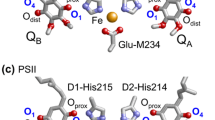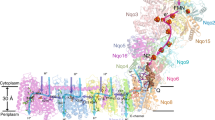Abstract
The Q cycle mechanism proposed by Peter Mitchell in the 1970’s explicitly considered the modification of ubiquinone two-electron redox properties upon binding to Complex III to match the thermodynamics of the other single-electron redox cofactors in the complex, and guide electron transfer to support the generation of a proton electro-chemical gradient across native membranes. A better understanding of the engineering of Complex III is coming from a now moderately well defined thermodynamic description of the redox components as a function of pH, including the Qi/heme b H cluster. The redox properties of the most obscure component, Qo, is finally beginning to be resolved.
Similar content being viewed by others
References
Cape JL, Bowman MK, Kramer DM (2007) Proc Natl Acad Sci U S A 104:7887–7892
Chance B (1952) In: Second International Conference of Biochemistry, Paris
Crofts AR, Holland JT, Victoria D, Kolling RJ, Dikanov SA, Gilbreth R, Lhjee S, Kuras R, Kuras MG (2008) Biochim Biophys Acta 1777:1001–1019
de la Rosa FF, Palmer G (1983) FEBS Lett 163:140–143
de Vries S, Albracht SPJ, Berden JA, Slater EC (1981) J Biol Chem 256(23):11996–11998
Ding H, Robertson DE, Daldal F, Dutton PL (1992) Biochemistry-Us 31(12):3144–3158
Dutton PL, Wilson DF, Lee CP (1970) Biochemistry-Us 9(26):5077–5082
Gray KA, Dutton PL, Daldal F (1994) Biochemistry-Us 33(3):723–733
Junemann S, Heathcote P, Rich PR (1998) J Biol Chem 273(34):21603–21607
Kolling DRJ, Samoilova RI, Holland JT, Berry EA, Dikanov SA, Crofts AR (2003) J Biol Chem 278(41):39747–39754
Malkin R (1981) Febs Lett 131:169–172
Mitchell P (1961) Nature 191:144–148
Mitchell P (1975a) FEBS Lett 59:137–139
Mitchell P (1975b) FEBS Lett 56:1–6
Mitchell P (1976) J Theor Biol 62:327–367
Osyczka A, Dutton PL, Moser CC, Darrouzet E, Daldal F (2001) Biochemistry-Us 40:14547–14556
Osyczka A, Moser CC, Daldal F, Dutton PL (2004) Nature 427(6975):607–612
Osyczka A, Moser CC, Dutton PL (2005) Trends Biochem Sci 30(4):176–182
Pettigrew GW, Meyer TE, Bartsch RG, Kamen MD (1976) Biochim Biophys Acta 430(2):197–208
Rich PR, Jeal AE, Madgwick SA, Moody AJ (1990) Biochim Biophys Acta 1018(1):29–40
Robertson DE, Prince RC, Bowyer JR, Matsuura K, Dutton PL, Ohnishi T (1984) J Biol Chem 259:1758–1763
Salerno JC, Xu Y, Osgood MP, Kim CH, King TE (1989) J Biol Chem 264(26):15398–15403
Sharp RE, Gibney BR, Palmitessa A, White JL, Dixon JA, Moser CC, Daldal F, Dutton PL (1999) Biochemistry-Us 38(45):14973–14980
Siedow JN, Power S, de la Rosa FF, Palmer G (1978) J Biol Chem 253:2392–2399
Takamiya K, Dutton PL (1979) Biochim Biopphys Acta 546:1–16
Ugulava NB, Crofts AR (1998) FEBS Lett 440:409–413
Wikstrom MK, Berden JA (1972) Biochim Biophys Acta 283(3):403–420
Zhang HB, Osyczka A, Moser CC, Dutton PL (2006) Biochemistry-Us 45(48):14247–14255
Zhang HB, Osyczka A, Dutton PL, Moser CC (2007) Biochim Biophys Acta 1767:883–887
Zhu J, Egawa T, Yeh S-R, Yu L, Yu CA (2007) Proc Natl Acad Sci U S A 2007:4864–4869
Zu Y, Couture MM, Kolling DR, Crofts AR, Eltis LD, Fee JA, Hirst J (2003) Biochemistry-Us 42:12400–12408
Author information
Authors and Affiliations
Corresponding author
Additional information
Invited paper, special “Peter Mitchell 30th anniversary” issue of Journal of Bioenergetics and Biomembranes
Rights and permissions
About this article
Cite this article
Zhang, H., Chobot, S.E., Osyczka, A. et al. Quinone and non-quinone redox couples in Complex III. J Bioenerg Biomembr 40, 493–499 (2008). https://doi.org/10.1007/s10863-008-9174-6
Received:
Accepted:
Published:
Issue Date:
DOI: https://doi.org/10.1007/s10863-008-9174-6




